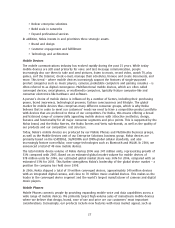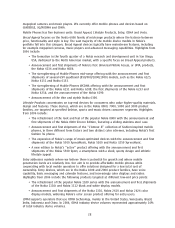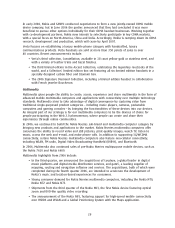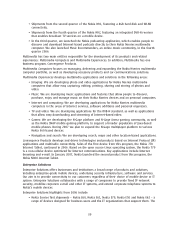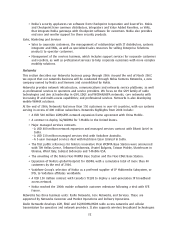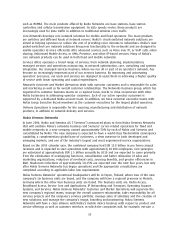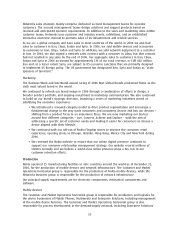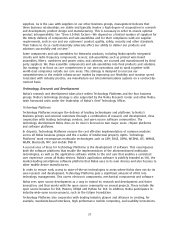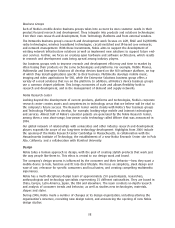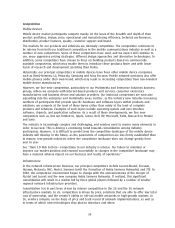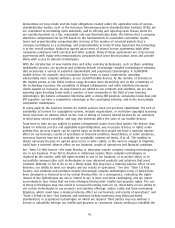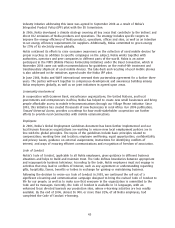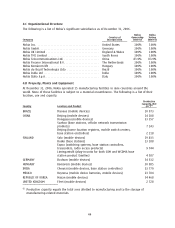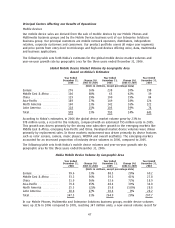Nokia 2006 Annual Report Download - page 38
Download and view the complete annual report
Please find page 38 of the 2006 Nokia annual report below. You can navigate through the pages in the report by either clicking on the pages listed below, or by using the keyword search tool below to find specific information within the annual report.suppliers. As is the case with suppliers to our other business groups, management believes that
these business relationships are stable and typically involve a high degree of cooperation in research
and development, product design and manufacturing. This is necessary in order to ensure optimal
product interoperability. See ‘‘Item 3.D Risk Factors—We depend on a limited number of suppliers for
the timely delivery of components and subassemblies and for their compliance with our supplier
requirements, such as our and our customers’ product quality, safety, security and other standards.
Their failure to do so could materially adversely affect our ability to deliver our products and
solutions successfully and on time.’’
Some components and subassemblies for Networks products, including Nokiaspecific integrated
circuits and radio frequency components; servers; subassemblies such as printed wire board
assemblies, filters, combiners and power units; and cabinets, are sourced and manufactured by third
party suppliers. We then assemble components and subassemblies into final products and solutions.
Our strategy is to focus on core competencies in our own operations and to work together with
worldclass companies outside our core areas. This strategy is designed to increase our
competitiveness in the mobile infrastructure market by improving our flexibility and reaction speed.
Consistent with industry practice, we manufacture our telecommunications systems on a contractby
contract basis.
Technology, Research and Development
Nokia’s research and development takes place within Technology Platforms and the four business
groups. Nokia’s technology strategy is also supported by the Nokia Research Center and other Nokia
wide horizontal units under the leadership of Nokia’s Chief Technology Officer.
Technology Platforms
Technology Platforms manages the delivery of leading technologies and platforms to Nokia’s
business groups and external customers through a combination of research and development, close
cooperation with leading technology vendors, and open source software communities. The
technology development Nokia does on its own is focused on two major areas: chipset platforms
and software platforms.
In chipsets, Technology Platforms ensures the cost effective implementation of common modules
across all Nokia business groups and the creation of intellectual property rights. Technology
Platforms’ work encompasses multiradio technologies such as GSM, EDGE, CDMA, WCDMA, LTE, WiMAX,
WLAN, Bluetooth, NFC and mobile DVBH.
A second area of focus for Technology Platforms is the development of software. This encompasses
both the software platforms that enable the implementation of the aforementioned multiradio
technologies, as well as the application software visible to the end user that enables a consistent
user experience across all Nokia devices. Nokia’s application software is publicly branded as S60, the
marketleading smartphone software platform that Nokia uses in its own devices and also licenses to
other mobile device manufacturers.
In order to ensure early access to stateoftheart technologies in areas where Nokia does not do its
own research and development, Technology Platforms puts a significant amount of effort into
technology management. This covers electronic components, mechanical components and software.
Nokia sees open source development as a way to extend its research and development and foster
innovation, and thus works with the open source community on several projects. These include the
open source browser for S60, Maemo, URIQA and Python for S60. In addition, Nokia participates in
industrywide open source projects, such as the Eclipse Foundation.
Technology Platforms also cooperates with leading industry players and alliances in creating, for
example, standardsbased interfaces, high performance mobile computing, and usability innovations.
37


